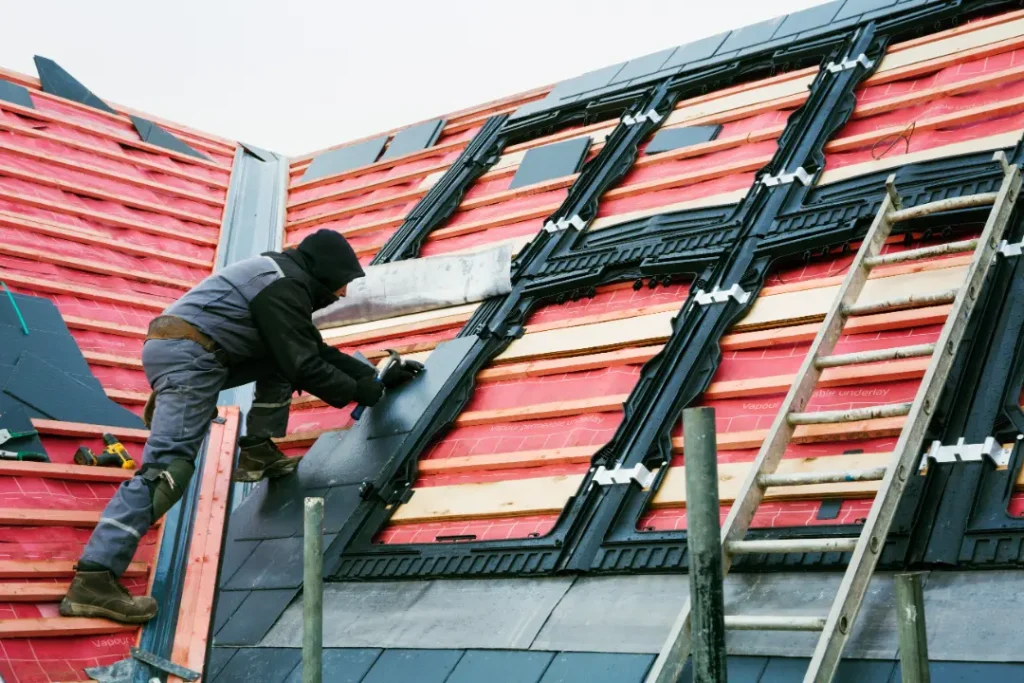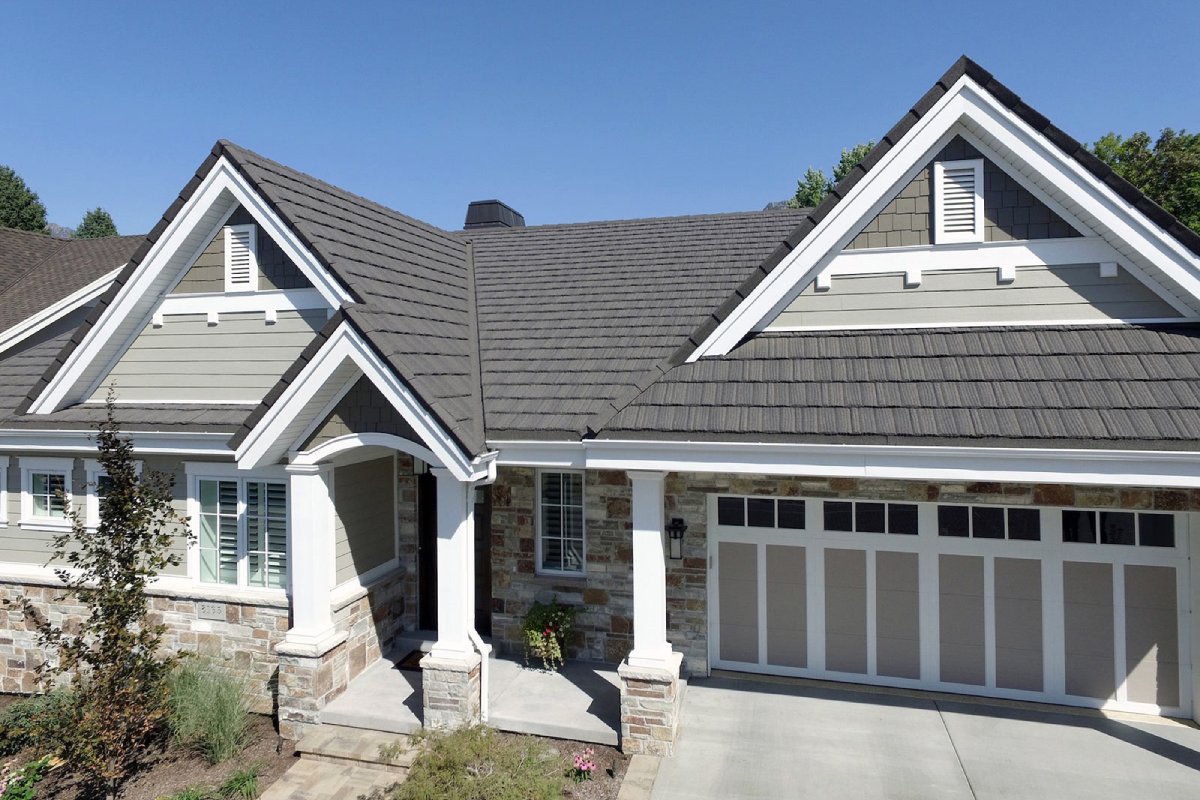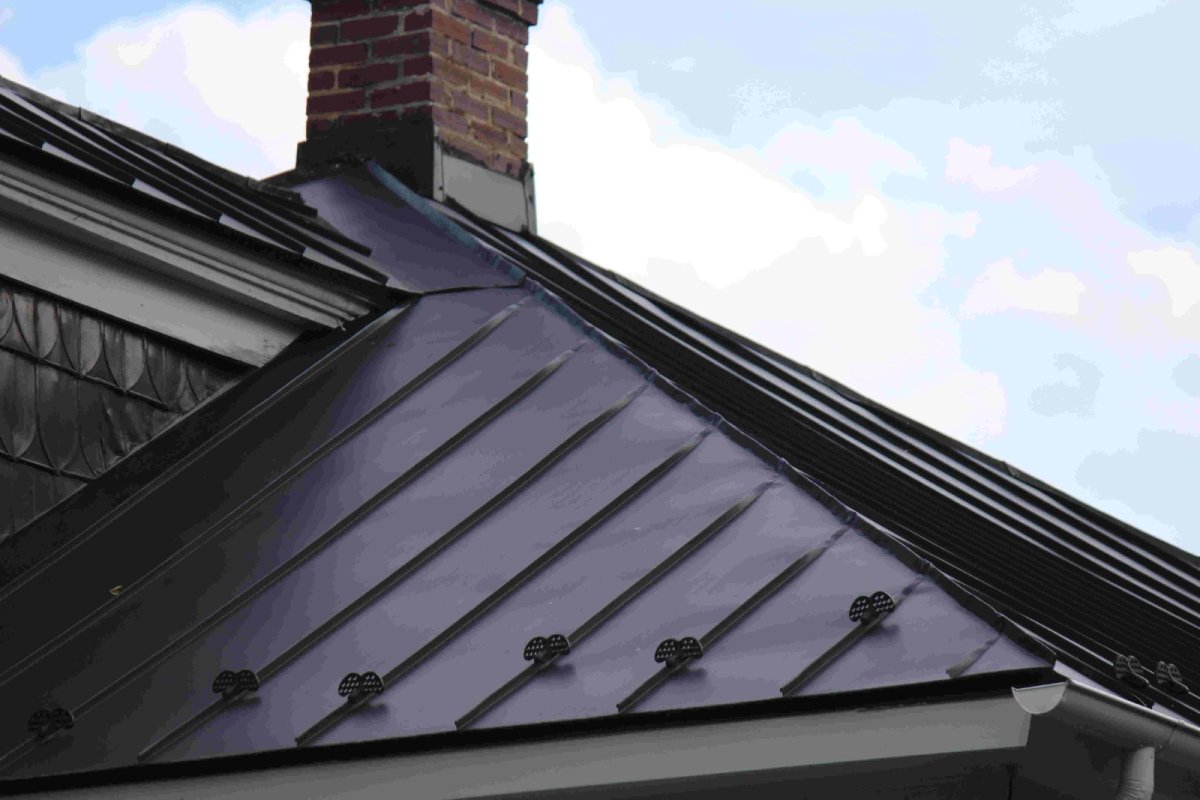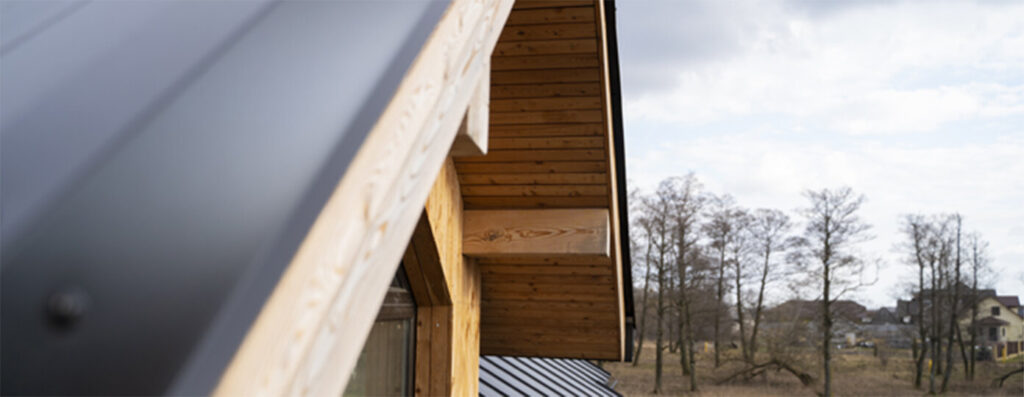Are you looking to install or replace your roof but unsure where to start? Our comprehensive guide to residential roofing installation breaks it all down. We’ll take you step-by-step through roof assessment, material selection, and installation. This guide will provide you with best practices to ensure a long-lasting and efficient roof.
Key Takeaways
- Regular roof inspections and identifying signs of damage early can prevent costly repairs and extend the roof’s lifespan.
- Choosing the right roofing material involves considering budget, climate, and desired durability. Options include asphalt shingles, metal, slate, tile, and wood.
- Proper roof installation and maintenance, including securing permits, planning and budgeting, and engaging a qualified professional roofer, are essential for the roof’s long-term performance and energy efficiency.
Start By Assessing Your Roofing Needs
Roofs can wear out over time due to weather, age, or damage; solar assessments are vital to catch problems early and prevent costly issues. You can identify roof damage through several signs, such as:
- Missing or damaged shingles
- Granules in the gutters
- Visible sagging
- Curling shingles
- Water stains on ceilings or walls
These indicators can help you recognize potential issues with your roof.
The first steps in any roofing project involve a comprehensive inspection and the critical decision to repair or replace your roof.

Conduct a Roof Inspection
A detailed roof inspection is necessary for pinpointing issues that could impair your roof’s performance. Start by inspecting both the interior and exterior of your home. Look for water stains, mold, and damaged shingles. Use a sturdy ladder to check for loose shingles, missing or damaged flashing, and any gaps or rust that could cause leaks.
Preventing moss growth is critical, as it can lead to water retention and damage to roofing materials, ultimately leading to expensive repairs and maintenance. Finally, inspect the flashing around chimneys, vents, and skylights for any potential issues.
Decide Between Repair and Replacement
The decision to repair or replace your roof requires consideration of several factors. If your roof is more than 20 years old and out of warranty, it may be time for a replacement, even if no obvious damage is present. Assess the extent of the damage and the condition of the roof structure, and consider whether simple spot repairs can address the problems.
Excessive moss and lichen growth can also signify that a full replacement is necessary.
Choose the Right Roofing Material
The choice of roofing material is a consequential decision that affects your home’s durability, energy efficiency, and visual appeal. Common types of residential roofing materials include:
- Asphalt shingles
- Tile
- Metal
- Wood
- Slate
Factors to consider when choosing a material include your budget, local climate, and personal preferences.
Each material offers different benefits, from affordability and versatility to durability and environmental impact.
Asphalt Shingles
Asphalt shingles are a popular choice for their affordability and ease of installation. They come in various styles and colors, allowing homeowners to achieve the desired look for their roofs. Made from fiberglass, asphalt, and ceramic granules, these shingles are:
- Affordable
- Easy to install
- Durable
- It can last up to 30 years or more.
A consultation with a professional roofer can guide you to the optimal design and guarantee the correct installation.
Metal Roofs
Metal roofs, often made from metal panels, are known for their durability, lightweight nature, and energy efficiency. Common metals used in roofing include steel, aluminum, copper, and alloy. These materials are widely utilized in various industries for their specific properties and applications. These roofs can last over 50 years with proper maintenance.
Additionally, metal roofing’s sunlight reflection capability can considerably lower cooling costs.
Slate Roofing
Slate roofing offers timeless elegance and a sophisticated appearance. It is known for its exceptional durability and can last over a century with proper maintenance. Slate roofs are highly resistant to fire and rot, making them an excellent choice for long-term investment.
Nevertheless, considering the structural support needed for these heavy materials is essential.
Tile Roofs
Tile roofs, available in ceramic, concrete, or clay materials, are known for their:
- Fire resistance
- Durability
- Ability to endure severe weather conditions
- Long lifespan, often lasting between 50 and 100 years
While they have a higher upfront cost, the longevity and durability of tile roofs make them a worthwhile investment.
Wood Shakes and Shingles
Wood shakes and shingles provide a natural, traditional look to homes. Made from split cedar logs, these roofing materials require regular maintenance to prevent damage from moss and mildew. With proper care, wood shingles can last between 25 and 30 years. However, they may not be suitable for all areas, particularly those with strict fire regulations.
Prepare for the Roof Installation
Proper preparation is pivotal for a successful roof installation. Here are some steps to follow:
Obtain Necessary Permits
Securing the necessary permits is pivotal to guarantee your roofing project’s compliance with local regulations and building codes. Building permits are regulatory tools used by municipalities to ensure safety standards are met. You must submit a detailed project plan, pay a fee, and await approval.
Some cities may also require an inspection during or after the project to ensure compliance.
Efficient Planning and Budgeting
Efficient planning and budgeting are key to a seamless roofing project. Create a detailed project plan that includes the type of roofing material and installation methods. Consider factors like roof size, materials, and labor costs. It’s wise to budget an additional 10% for unexpected issues. Quality materials and proper installation can save money in the long run by reducing the need for repairs and replacements.
Scheduling the project during stable weather conditions can prevent delays and additional costs.
The Roof Installation Process
The roof installation process encompasses several vital steps to guarantee a durable, long-lasting roof. It includes:
- Removing the old roof
- Repairing the roof deck
- Installing underlayment
- Adding new shingles
Proper installation techniques and materials are essential at each step to prevent future issues and ensure the roof’s longevity.

Remove the Old Roof
Removing the old roof is a meticulous process that requires safety precautions and careful execution. Here are the steps to follow:
- Start at the peak of the roof, prying up ridge caps.
- Remove shingles row by row.
- After removing all shingles, assess and remove old flashing, vents, and pipe boots.
Clean-up involves using tarps, a dumpster, and a rolling magnet to ensure the property is left safe and tidy.
Repair the Roof Deck
The roof deck needs repair to establish a solid foundation for the new roof, as it is crucial to address any issues with the existing roof. This step involves removing old nails and repairing any damaged plywood or rafters.
Ensuring a sturdy base prevents potential problems and extends the roof’s longevity.
Install Underlayment
The installation of underlayment is a vital step to provide additional moisture protection. A quality felt underlayment is commonly used and applied to the roof deck to serve as an extra layer of protection against moisture. This step ensures the durability and effectiveness of the roofing system.
Shingle Installation
Precision is imperative to ensure optimal roof performance during the pivotal phase of shingle installation. Shingles must be installed according to the manufacturer’s guidelines to ensure proper adhesion and performance. Starter shingles are placed along the roof’s edges to strengthen and protect against weather impacts.
Following these guidelines is essential to achieve a durable and weather-resistant roof.
Flashing and Ventilation
Correct flashing and ventilation are essential to prevent leaks and uphold energy efficiency. Flashing is installed to protect vulnerable areas like:
- Eaves
- Valleys
- Chimneys
- Skylights
from water infiltration.
Ensuring proper attic ventilation helps maintain temperature and moisture levels, extending the roof’s lifespan. This combination is crucial for a fully functional and efficient roof system.
Final Inspection and Clean-Up
The concluding phase of inspection and cleanup guarantees that the roofing project adheres to all standards and leaves the property neat. During the final inspection, the roof is checked for compliance with building codes and aesthetic standards. Clean-up involves removing debris, including nails, and ensuring the property is safe and clean. This step is essential to concluding the roofing process professionally.
Post-Installation Maintenance
Post-installation roof maintenance is essential to preserve its integrity and prolong its lifespan. Key practices include regular inspections, proper attic ventilation, and cleaning gutters and overhanging branches.
These steps help catch issues early and prevent damage from accumulating, ensuring your roof remains in top condition.
Regular Inspections
Regular inspections are vital for early detection of issues and prolonging your roof’s lifespan. Inspect the roof at least twice a year and after severe weather events to spot missing shingles, cracks, or moss growth. Regular professional inspections can reveal issues that might be overlooked during DIY inspections.
This proactive approach ensures your roof performs optimally for years to come.
Proper Attic Ventilation
Maintaining adequate attic ventilation has several benefits:
- It inhibits heat buildup and moisture accumulation, which could harm your roof and shorten its lifespan
- Helps maintain temperature and moisture levels, preventing damage
- Reduces the risk of mold growth
This step is crucial for maintaining a cool roof and preventing rot and mold in the attic.
Cleaning Gutters and Overhanging Branches
Regular gutter cleaning and trimming of overhanging branches are essential maintenance tasks. Cleaning gutters regularly prevents blockages that can lead to water damage. Trimming tree limbs hanging over the roof protects against gutter clogs and damaged shingles during storms or high winds.
These practices help maintain the roof’s integrity and prevent potential hazards.
Energy Efficiency Considerations
Factoring in energy efficiency when choosing your roofing can substantially cut down on energy costs and enhance comfort. Factors like solar reflectance and proper ventilation play key roles in the roof’s energy efficiency.
An energy-efficient roof can lower your utility bills by up to 25 percent and extend the life of your HVAC system by reducing its workload.
Cool Roofs and Reflective Materials
Engineered to increase sunlight reflection and minimize heat absorption, cool roofs, and reflective materials are superior alternatives to traditional roofs. This is meant to help decrease the urban heat island effect and lower building energy costs. Metal roofs, for instance, can reflect solar radiant heat, contributing to energy savings.
Additionally, cool roofs can reduce local air temperatures, helping mitigate the urban heat island effect.
Insulation Upgrades
Insulation upgrades during roof installation are essential for boosting energy efficiency. Adequate attic insulation prevents heat and moisture buildup that can damage your roof.
Cedar wood shakes, for example, provide natural insulation, helping to reduce energy costs. Ensuring your roof is well-insulated can lead to significant savings on energy bills.
Hiring a Professional Roofer
Engaging a professional roofer guarantees correct installation and sustained performance of your roof. Asking the right questions will help you find a contractor who aligns with your project goals and expectations.

Key Qualifications
When hiring a professional roofer, it’s important to verify their licenses, insurance, and certifications, like SELECT ShingleMaster or GAF MasterElite. As a reputable roofing company in Wilmington, NC and High Point, Xterior LLC holds top industry certifications to ensure quality and reliability in every project.. This ensures that the roofer has the necessary skills and experience to handle your roofing project.
Checking their past work and customer reviews can also provide insights into their quality and reliability.
Questions to Ask
Ask potential contractors about their project execution plan, materials they suggest, and their process. Clear communication and a thorough understanding of the project scope and timeline are essential in determining if the contractor fits your project. Ensure they offer a detailed written estimate and warranties on both materials and workmanship.
Understanding Warranties and Guarantees
Grasping the warranties and guarantees is vital for safeguarding your investment in a new roof. A new roof generally comes with two types of warranties: one for the materials and another for the contractor’s workmanship. Knowing the details of these warranties can provide peace of mind and ensure you are covered for any potential issues.
Material Warranties
Material warranties typically cover faulty materials and components but usually don’t include labor and tear-off costs. For example, standard warranties on architectural asphalt shingles can last 30 years but start prorating after 10 years.
Some manufacturers offer enhanced warranties that provide non-prorated coverage if all roofing components come from one manufacturer and are installed by a certified contractor.
Workmanship Guarantees
Workmanship guarantees hold the contractor accountable for fixing any issues caused by incorrect installation of roofing materials. These warranties can vary from:
- 2 years
- 5 years
- 10 years
- Lifetime
depending on the contractor.
Ask contractors if they offer a warranty on labor and roofing materials to ensure you are covered for any installation errors.
Xterior LLC: Your Trusted Partner for Residential Roofing
Xterior LLC is well-known for its professional approach, commitment to communication, and superior craftsmanship. Our company offers a wide range of exterior home services, including:
- Roof replacement
- Siding
- Windows
- Gutters
And more.
Our services are tailored to meet North Carolina’s unique needs and climate challenges, ensuring durable and aesthetically pleasing results.
Why Choose Xterior LLC
Opting for Xterior LLC allows you to partner with a company that:
- Upholds stringent quality control standards.
- Values customer satisfaction.
- Has an A+ rating from the Better Business Bureau (BBB).
- Has Google Guaranteed status.
Xterior LLC is a standout in the industry, offering superior customer service and quality craftsmanship. Based in North Carolina, Xterior LLC has built a strong reputation in the industry. Our company uses high-quality, durable materials for long-lasting services. Contact us today to request an estimate.. Take action today to keep your roof in top condition and protect your home for years to come.
Summary
Summing up, a successful roofing project involves assessing your roofing needs, choosing the right materials, planning, and budgeting effectively, and following a thorough installation process.
Post-installation maintenance and considering energy efficiency can further enhance the longevity and performance of your roof. Hiring a professional roofer and understanding warranties and guarantees are crucial steps in protecting your investment.
At Xterior LLC, we stand out as a trusted partner committed to delivering high-quality craftsmanship and exceptional customer service. Take the first step towards a durable and beautiful roof by consulting with Xterior LLC today.
Frequently Asked Questions
What are the common signs of roof damage?
You may have roof damage if you notice missing or damaged shingles, granules in gutters, visible sagging, curling shingles, or water stains on ceilings or walls. It’s important to address these signs promptly to prevent further issues.
How do I decide between repairing and replacing my roof?
You should consider the roof’s age, damage extent, and structural issues. If the roof is over 20 years old or out of warranty, replacement might be necessary.
What are the benefits of metal roofs?
Metal roofs offer durability, lightweight construction, energy efficiency, and various finishes, making them a long-lasting option with proper maintenance.
Why is proper attic ventilation important?
Proper attic ventilation is important because it prevents heat buildup and moisture accumulation, which can damage the roof and reduce its lifespan.
What should I ask a potential roofing contractor?
When looking for a potential roofing contractor, inquire about their project execution plan, suggested materials, licenses, insurance, and guarantees on workmanship and materials. These are essential aspects to consider when making your decision.
Disclaimer:
The content in this blog is for informational purposes only and is intended to assist homeowners in understanding roofing, siding, windows, gutters, shutters, and general home improvements. Xterior LLC advises against attempting any of the tasks described here, as they require professional expertise. We do not assume liability for any injuries, damages, or losses resulting from DIY attempts. Always refer to the manufacturer of products for specific maintenance instructions.
By viewing this blog, you acknowledge and release Xterior LLC from any and all liability related to the use or misuse of the information provided.
Please note that Xterior LLC may not offer all the services discussed. Repairs, estimates, and inspections are priced based on availability, location, and time. All services, offerings, and prices are subject to change without notice.
For more information or to request services, please contact Xterior LLC directly.





